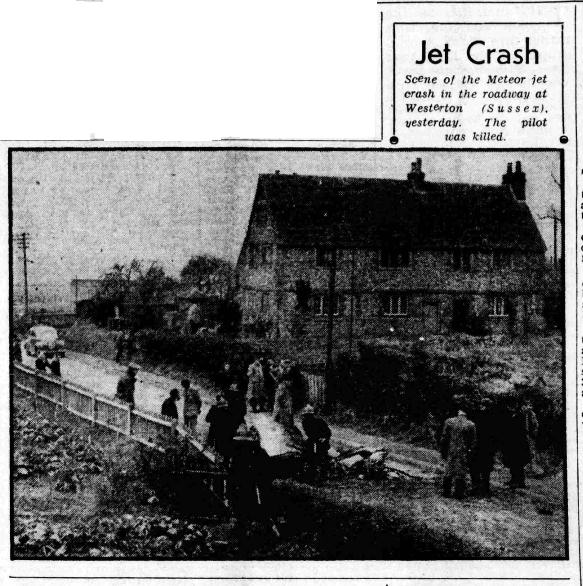
ASN Wikibase Occurrence # 20274
This information is added by users of ASN. Neither ASN nor the Flight Safety Foundation are responsible for the completeness or correctness of this information.
If you feel this information is incomplete or incorrect, you can submit corrected information.
| Date: | Sunday 24 February 1952 |
| Time: | 12:00 LT |
| Type: |  Gloster Meteor T Mk 7 |
| Owner/operator: | 500 (County of Kent) Sqn RAF |
| Registration: | WA726 |
| MSN: | |
| Fatalities: | Fatalities: 1 / Occupants: 1 |
| Aircraft damage: | Destroyed |
| Location: | 9-14 Stane Street, Westerton, West Sussex, England -
 United Kingdom United Kingdom
|
| Phase: | Approach |
| Nature: | Training |
| Departure airport: | RAF West Malling, Maidstone, Kent |
| RAF Tangmere, Chichester, West Sussex | |
| Confidence Rating: |
WA726: Meteor T.7 coded "S7-Y" of 500 (County of Kent) Squadron RAF. Written off (destroyed) 24 February 1952. Stalled and crashed into gardens at Westerton, Sussex. The pilot was killed. It was seen to be making a turn onto final approach at low speed and with the airbrakes extended and it is believed that the Meteor stalled in this configuration.
Crew:
Sgt (2680093) Alfred Lionel David WALKER (pilot) RAF - killed
According to a contemporary newspaper report ("Portsmouth Evening News" - Monday 25 February 1952):
"Westerton was a village of miracle escapes.
Petty Officer saves baby as plane explodes.
Inhabitants of Westerton had a miraculous escape at mid-day yesterday when an RAF aircraft, a Meteor VII crashed in the middle of the hamlet killing the pilot. No-one else was hurt.
The narrowest was that of Petty Officer William Merritt's one month old baby, John, who was sleeping in his pram in the garden of 14 Westerton.
Wreckage fell all around the pram and kerosene from the aircraft's fuel tank splashed on the clothes inside. Petty Officer Merritt, who is stationed in HMS Adamant, was on leave and was in the cottage with his wife and four children. When the explosion came he dashed out side for the baby and carried him inside.
The pilot was Sergeant Alfred Lionel David Walker of The Royal Auxiliary Air Force and was flying a Meteor training plane from West Malling RAF Station in Kent to Tangmere.
Housewives were busy cooking there Sunday roasts when the crash came. Skimming the tree tops at about 50 feet from the ground the aeroplane came in from an Easterly direction when it suddenly dived.
It thudded into the garden of 9 Westerton, the home of Mr and Mrs Robert Emmerson half way between the house and the road.
So often do aircraft fly low over the houses few of the villagers bothered to look up on this occasion until the sound of the crash. The one man known to have seen the impact, Mr John Todic, a Slav farm worker, told the Evening News that he was walking in the road nearby when it occurred. After hearing the aircraft's high speed plunge to earth, he told how it had half bounced and half ploughed it's way into the next garden about 25 yards from where it exploded.
Meanwhile the pilot had been thrown clear but was dead. His watch strap had broken and his watch, still ticking was lying in the road some yards away.
Widely Scattered.
The force of the explosion sent fragments of the aircraft as far as 100 yards from the point where the aircraft crashed When Chichester Fire brigade arrived they found eight or nine small fires in wreckage scattered about an acre. Flying fragments broke windows and dislodged roof tiles of nearby houses.
As the aircraft passed down it passed directly over the head of Mr. W J Piggott who was in his garden trimming his ivy covered wall and hit the ground about twenty yards behind him. Most of the force of the explosion, fortunately for him, was spent in the opposite direction. Mr Emmerson had been working in his garden in the morning and his daughter Carolyn (4) was playing nearby. About two minutes after being called in by Mrs Emmerson to have a cup of coffee, they heard the aircraft crash at the point where they had been standing."
Sources:
1. Halley, James (1999) Broken Wings – Post-War Royal Air Force Accidents Tunbridge Wells: Air-Britain (Historians) Ltd. p.125 ISBN 0-85130-290-4.
2. Last Take-off: A Record of RAF Aircraft Losses 1950 to 1953 by Colin Cummings p 224
3. Royal Air Force Aircraft WA100-WZ999 (James J Halley, Air Britain, 1983 p 12)
4. Portsmouth Evening News" - Monday 25 February 1952
5. Inquest Into Death of Pilot: West Sussex Gazette - Thursday 6 March 1952
6. https://en.wikipedia.org/wiki/Westhampnett#Civil_parish
7. http://sussexhistoryforum.co.uk/index.php?topic=2274.0
8. http://www.ukserials.com/results.php?serial=WA
9. https://www.rauxaf.net/page157.html
Images:

Revision history:
| Date/time | Contributor | Updates |
|---|---|---|
| 31-May-2008 11:44 | JINX | Added |
| 07-Jun-2008 11:52 | JINX | Updated |
| 14-Jun-2013 18:23 | Nepa | Updated [Aircraft type, Operator, Location, Destination airport] |
| 04-Jul-2015 19:17 | snapper_five | Updated [Aircraft type, Location, Departure airport, Destination airport, Narrative, Photo, ] |
| 05-Feb-2020 21:20 | Dr. John Smith | Updated [Time, Operator, Total occupants, Location, Departure airport, Destination airport, Source, Narrative] |
| 05-Feb-2020 21:45 | stehlik49 | Updated [Operator, Operator] |
| 19-May-2021 09:18 | Anon. | Updated [Aircraft type, Location, Nature, Source, Narrative, Operator] |
| 16-Jul-2022 22:22 | Dr. John Smith | Updated [Source, Narrative, Category] |
Corrections or additions? ... Edit this accident description
The Aviation Safety Network is an exclusive service provided by:


 ©2024 Flight Safety Foundation
©2024 Flight Safety Foundation